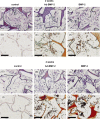Gene transfer strategies in tissue engineering
- PMID: 17488473
- PMCID: PMC3822823
- DOI: 10.1111/j.1582-4934.2007.00027.x
Gene transfer strategies in tissue engineering
Abstract
Aiming for regeneration of severed or lost parts of the body, the combined application of gene therapy and tissue engineering has received much attention by regenerative medicine. Techniques of molecular biology can enhance the regenerative potential of a biomaterial by co-delivery of therapeutic genes, and several different strategies have been used to achieve that goal. Possibilities for application are many-fold and have been investigated to regenerate tissues such as skin, cartilage, bone, nerve, liver, pancreas and blood vessels. This review discusses advantages and problems encountered with the different gene delivery strategies as far as they relate to tissue engineering, analyses the positive aspects of polymeric gene delivery from matrices and discusses advances and future challenges of gene transfer strategies in selected tissues.
Figures


Similar articles
-
Viral vectors for gene delivery in tissue engineering.Adv Drug Deliv Rev. 2006 Jul 7;58(4):515-34. doi: 10.1016/j.addr.2006.03.006. Epub 2006 Jun 9. Adv Drug Deliv Rev. 2006. PMID: 16762441 Review.
-
Hydrogels in Gene Delivery Techniques for Regenerative Medicine and Tissue Engineering.Macromol Biosci. 2024 Jun;24(6):e2300577. doi: 10.1002/mabi.202300577. Epub 2024 Feb 6. Macromol Biosci. 2024. PMID: 38265144 Review.
-
Natural polymers for gene delivery and tissue engineering.Adv Drug Deliv Rev. 2006 Jul 7;58(4):487-99. doi: 10.1016/j.addr.2006.03.001. Epub 2006 Jun 9. Adv Drug Deliv Rev. 2006. PMID: 16762443 Review.
-
New cell engineering approaches for cartilage regenerative medicine.Biomed Mater Eng. 2017;28(s1):S201-S207. doi: 10.3233/BME-171642. Biomed Mater Eng. 2017. PMID: 28372296 Review.
-
Non-viral gene delivery to mesenchymal stem cells: methods, strategies and application in bone tissue engineering and regeneration.Curr Gene Ther. 2011 Feb;11(1):46-57. doi: 10.2174/156652311794520102. Curr Gene Ther. 2011. PMID: 21182464 Review.
Cited by
-
Electrical Field-Assisted Gene Delivery from Polyelectrolyte Multilayers.Polymers (Basel). 2020 Jan 6;12(1):133. doi: 10.3390/polym12010133. Polymers (Basel). 2020. PMID: 31935814 Free PMC article.
-
Multifunctional nanoscale strategies for enhancing and monitoring blood vessel regeneration.Nano Today. 2012 Dec;7(6):514-531. doi: 10.1016/j.nantod.2012.10.007. Epub 2012 Nov 17. Nano Today. 2012. PMID: 28989343 Free PMC article.
-
T17b murine embryonal endothelial progenitor cells can be induced towards both proliferation and differentiation in a fibrin matrix.J Cell Mol Med. 2009 May;13(5):926-35. doi: 10.1111/j.1582-4934.2008.00527.x. J Cell Mol Med. 2009. PMID: 19538255 Free PMC article.
-
Sonoporation increases therapeutic efficacy of inducible and constitutive BMP2/7 in vivo gene delivery.Hum Gene Ther Methods. 2014 Feb;25(1):57-71. doi: 10.1089/hgtb.2013.113. Epub 2013 Nov 27. Hum Gene Ther Methods. 2014. PMID: 24164605 Free PMC article.
-
Fibrin gel-immobilized VEGF and bFGF efficiently stimulate angiogenesis in the AV loop model.Mol Med. 2007 Sep-Oct;13(9-10):480-7. doi: 10.2119/2007-00057.Arkudas. Mol Med. 2007. PMID: 17762899 Free PMC article.
References
-
- Langer R, Vacanti JP. Tissue engineering. Science. 1993;260:920–23. - PubMed
-
- Green H. Cultured cells for the treatment of disease. Sci Am. 1991;254:96–102. - PubMed
-
- Bell E, Ehrlich HP, Buttle DJ, Nakatsuji T. Living tissue formed in vitro and accepted as skin-equivalent tissue of full thickness. Science. 1981;211:1052–4. - PubMed
-
- Anderson WF. Human gene therapy. Nature. 1998;392:25–30. - PubMed
Publication types
MeSH terms
LinkOut - more resources
Full Text Sources

